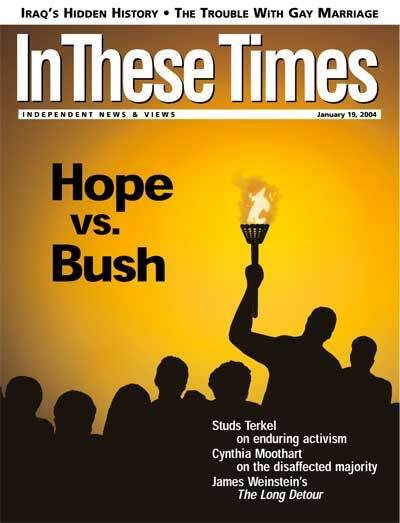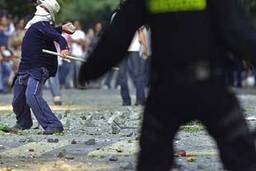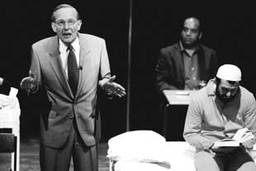
On November 25, in the Colombian city of Medellin, 855 paramilitary fighters belonging to the Cacique Nutibara Bloc—a satellite of Carlos Castaño’s formidable paramilitary force, the AUC (Autodefensas Unidas de Colombia)—filed at dawn into the vast downtown Convention Hall to surrender to the Colombian government. This demobilization was hailed by government spokesmen as the first step of a process intended to dismantle the AUC’s paramilitary structure.
The Nutibara soldiers were received by local officials and the Colombian Peace Commissioner, Luis Carlos Restrepo, who declared this a “huge advance and demonstration of peace.” The mayor announced, “Peace smiles on Medellin.” The troops observed a minute of silence for war victims, sang the national anthem and cheered the appearances, telecast on a giant screen, of a trio of AUC leaders: founder and political chief Castaño, military chief Salvatore Mancuso and Nutibara commander Diego Murillo, alias “Don Berna.”
Both Castaño and Mancuso have been convicted of massacres, murders and drug crimes, and are wanted in extradition by the United States, while Murillo is a former associate of Pablo Escobar’s Medellin cartel and allegedly Colombia’s most notorious Mafioso. All three laid down their arms. But something was wrong: There were only 200 rusty, aging assault rifles, sawed-off shotguns and pistols. Nothing resembled the sleek, heavy-duty submachine guns and repeat assault rifles seen by journalists on the streets the day before.
This carefully stage-managed ceremony was broadcast nationwide on a government television network. The show disturbed many people. No one disputes the desirability of removing the paramilitaries from the war. But the president’s discussions with paramilitary leadership have been conducted secretly. Absent transparency, accountability or any forum for consultation or analysis, the president and his peace commissioner appear to have embarked on a dangerous, improvised journey, hand-in-hand with some of the most ruthless criminals thrown up by Colombia’s horrendous war, without a map, compass or monitor, and without any consideration for Colombia’s obligations under international laws.
Last July, President Uribe cut a deal with paramilitary leadership, agreeing that the AUC’s 13,000 troops would demobilize by December 31, 2005. Subsequently, the peace commissioner revealed that the government was introducing special legislation to permit individuals who had committed crimes not covered under existing amnesty laws to make cash payments in lieu of jail time.
“Checkbook impunity” is how Human Rights Watch characterized this proposed legislation. Restrepo explained that “rather than serving time in prison, there are alternative sentences and the individuals will be allowed to pay reparations.”
There is no mystery about the motives or agenda of the paramilitaries. They have done the job they were created for 20 years ago: The guerrilla advance has been stemmed and the left-wing democratic opposition almost eliminated.
Through brutal land-cleansing campaigns, paras and their Mafia associates own more than 40 percent of Colombia’s best land and richest resources and now want political power. That requires amnesty and legitimacy. Their only obstacle: the United States, which has put them on the terrorist list and sought their extradition.
The question that haunts this entire process is why is Uribe so determined to give it to them? Yet suppose this is the wrong question. What if, in his dealings with the AUC and its associates, the president is not free to act as the autonomous agent of a sovereign state?
Fernando Mora, Bogota director of the International Crisis Group, raised this very issue just days after the Medellin broadcast. It was essential, he said, that the government communicates the message that there was “a legitimate government and a president in charge [of the process]. The sensation exists that the people who have financed the paramilitaries are the ones in charge.” When asked to whom he was referring, Mora said it was no secret that “certain sectors of the Colombian elite,” like the industrialists connected to the agricultural sector, financed the paramilitaries. “These financial elite are the ones who have said how the negotiations should be conducted, who the spokesmen should be and how they are to be treated.
“So,” he asked, “where is the government?”
The Nutibara soldiers were received by local officials and the Colombian Peace Commissioner, Luis Carlos Restrepo, who declared this a “huge advance and demonstration of peace.” The mayor announced, “Peace smiles on Medellin.” The troops observed a minute of silence for war victims, sang the national anthem and cheered the appearances, telecast on a giant screen, of a trio of AUC leaders: founder and political chief Castaño, military chief Salvatore Mancuso and Nutibara commander Diego Murillo, alias “Don Berna.”
Both Castaño and Mancuso have been convicted of massacres, murders and drug crimes, and are wanted in extradition by the United States, while Murillo is a former associate of Pablo Escobar’s Medellin cartel and allegedly Colombia’s most notorious Mafioso. All three laid down their arms. But something was wrong: There were only 200 rusty, aging assault rifles, sawed-off shotguns and pistols. Nothing resembled the sleek, heavy-duty submachine guns and repeat assault rifles seen by journalists on the streets the day before.
This carefully stage-managed ceremony was broadcast nationwide on a government television network. The show disturbed many people. No one disputes the desirability of removing the paramilitaries from the war. But the president’s discussions with paramilitary leadership have been conducted secretly. Absent transparency, accountability or any forum for consultation or analysis, the president and his peace commissioner appear to have embarked on a dangerous, improvised journey, hand-in-hand with some of the most ruthless criminals thrown up by Colombia’s horrendous war, without a map, compass or monitor, and without any consideration for Colombia’s obligations under international laws.
Last July, President Uribe cut a deal with paramilitary leadership, agreeing that the AUC’s 13,000 troops would demobilize by December 31, 2005. Subsequently, the peace commissioner revealed that the government was introducing special legislation to permit individuals who had committed crimes not covered under existing amnesty laws to make cash payments in lieu of jail time.
“Checkbook impunity” is how Human Rights Watch characterized this proposed legislation. Restrepo explained that “rather than serving time in prison, there are alternative sentences and the individuals will be allowed to pay reparations.”
There is no mystery about the motives or agenda of the paramilitaries. They have done the job they were created for 20 years ago: The guerrilla advance has been stemmed and the left-wing democratic opposition almost eliminated.
Through brutal land-cleansing campaigns, paras and their Mafia associates own more than 40 percent of Colombia’s best land and richest resources and now want political power. That requires amnesty and legitimacy. Their only obstacle: the United States, which has put them on the terrorist list and sought their extradition.
The question that haunts this entire process is why is Uribe so determined to give it to them? Yet suppose this is the wrong question. What if, in his dealings with the AUC and its associates, the president is not free to act as the autonomous agent of a sovereign state?
Fernando Mora, Bogota director of the International Crisis Group, raised this very issue just days after the Medellin broadcast. It was essential, he said, that the government communicates the message that there was “a legitimate government and a president in charge [of the process]. The sensation exists that the people who have financed the paramilitaries are the ones in charge.” When asked to whom he was referring, Mora said it was no secret that “certain sectors of the Colombian elite,” like the industrialists connected to the agricultural sector, financed the paramilitaries. “These financial elite are the ones who have said how the negotiations should be conducted, who the spokesmen should be and how they are to be treated.
“So,” he asked, “where is the government?”
Ana Carrigan, author of The Palace of Justice: A Colombian Tragedy, is a frequent contributor to In These Times.







